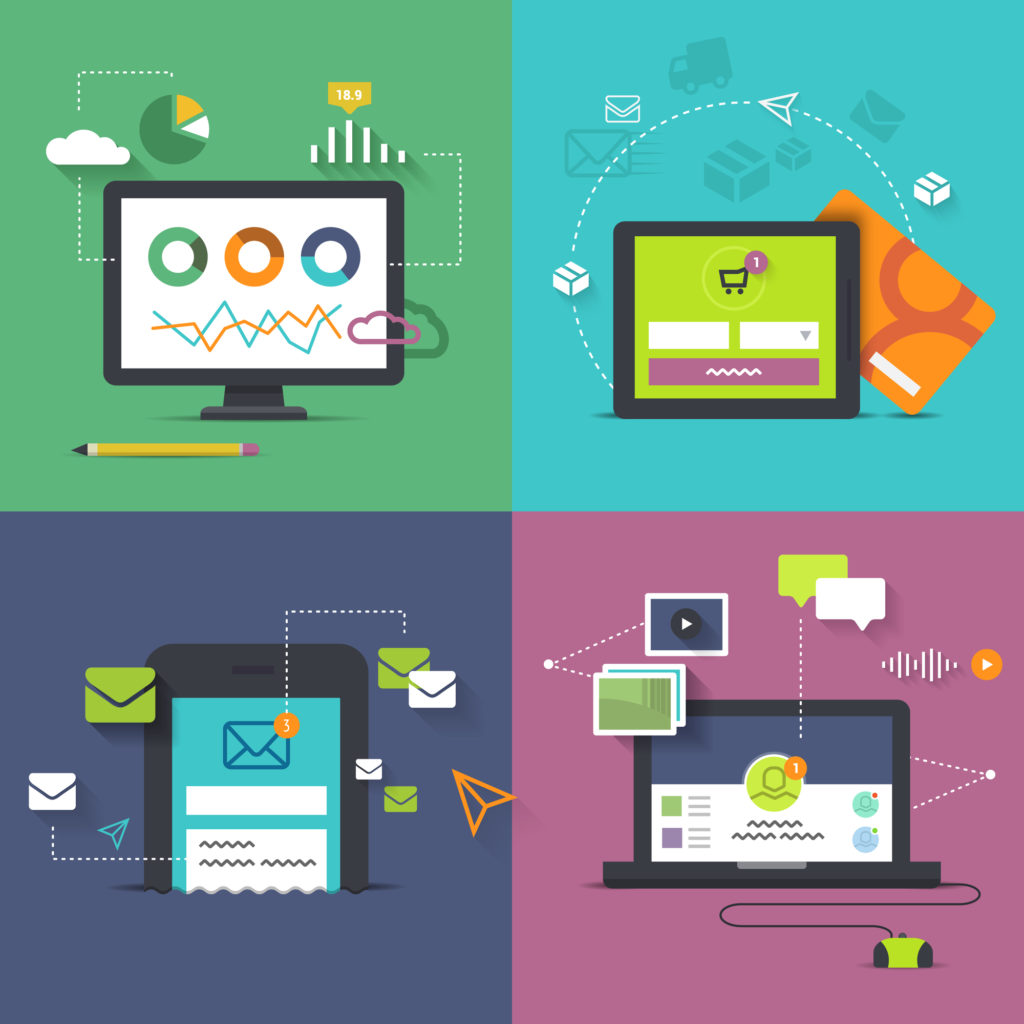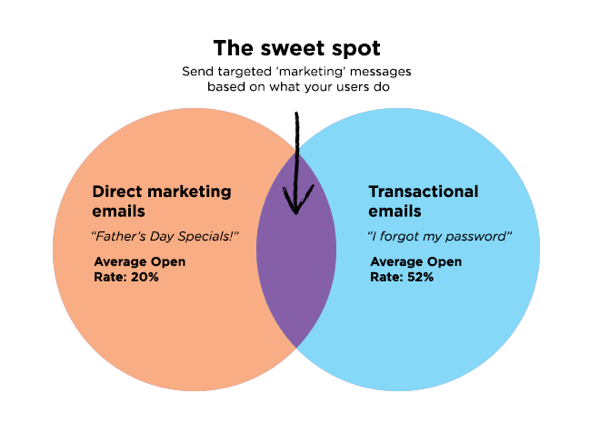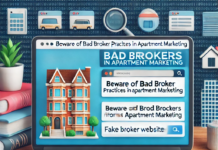In the constantly changing world of digital marketing, what still works? Of course, the world evolves, but between social media, SEO, SEM and the entire playbook what drives business growth? And what services provide sufficient return on your investment? Interestingly, one of the most tried and true activities remains email marketing services.
But isn’t email dead?
Nope.
Every day, people and businesses send about 280 billion emails. And reports indicate the numbers of daily emails continue to increase and should reach roughly 333 billion by 2021 (in just 2 more years!).
Additionally, email marketing yields significant returns. And these returns continue growing over time. For example, in 2015 a study by the DMA, showed the average email marketing campaign returns about $38 per $1. In 2017, the same DMA study showed the average email marketing campaign returned about $40 per $1. And yes, in 2018, the annual DMA study showed the average email marketing campaign returned roughly $43 per $1. So, for every $1 invested on email in 2015, business owners received $38. Last year, the same $1 investment returned $43! For comparison, Econsultancy produced expected ROI per common marketing channels.

But what causes these dramatic returns?
Loyalty.
Although we receive LOTS of email every day, consumers filter the signal and noise. As a result, when we are ready to buy and receive a business email, we are ready to act. In particular, if we opt in to business emails, then we WANT to remain informed of sales, new products and general updates.
What people do not want is simple. People do not want spam!
As a result, developing an email strategy and using tools that help you find quality leads help build effective email marketing campaigns.
How to Develop Your Email Marketing Strategy

Does your overall marketing strategy include email marketing? If not, review your current objectives and develop an email strategy.
Why?
“Research shows that of all marketing activities email marketing delivers the best ROI. Many SMBs use email marketing as a low-cost method of staying in touch with their customers and potential customers. Usually, companies will advertise an email opt-in on their site and build their database that way. As new offers and product updates arise, relevant segments of the database will be sent emails.”
So, how does a marketer jumpstart their email marketing strategy?
First and foremost, understand the various rationales to send an email. For example, email works for branding, engagement, acquisition, retention, sales, reactivation, traffic, referrals and more.
Digital Marketer provides a high level overview of creating an email strategy.
“Email marketing is more than broadcasting an email every time you publish a new blog post. And it’s more than sending email alerts when you have a promotion or sale. The outcome of strategic email marketing is indeed profit and growth, but the purpose of email marketing is to move your customers from one stage to the next. To master email marketing, you need to understand the types of emails you’ll use, their timing, and the different campaigns you’ll use to connect with your subscribers.”
Types of Emails
Therefore, part of a successful email strategy includes understanding what type of email to send for the right interaction.
- Transactional Email – think customer service. In a transactional email, focus on acquisition and retention because you want to focus on answering a customer questions. These may be existing or potential customers, so service is vital.
- Promotional Email – think sales. In promotional emails, focus on sales and engagement. Every company has a sales season, so think about how you will activate your existing customers (or new leads on your email list). Be unique and focus on a call-to-action.
- Relational Email – think company updates. In a relational email, focus on developing the brand and engagement. In these emails, do not focus on sales, but updates to the company or new hires (depending on your company). Share the behind the scenes or company pet to generate interest and personality.
Additionally, depending on your strategy, different email providers offer services that work for different niches. To help, review an email resource site that offers an apple to apples comparison of your various options.
Email Strategy Tips
As you develop your email marketing strategy, then a few tips always help. For starters, if you don’t have an existing email list, start now. It takes time to build a large distribution list organically. Conversely, some people decide to buy a list, however, this is not recommended.
“Purchased lists are ineffective. If you send emails to a list of people whose contact info you bought, many of the emails will get identified as spam. Some spam filters will flag a campaign if anyone with the same IP has sent spam in the past. When you use [an email provider, such as Mailchimp], your email is delivered through our servers, so if one person sends spam, it could prevent other users’ emails from reaching inboxes.”
So, how should one grow their email list? Experts, such as Neil Patel, offer a few options, such as providing invaluable (and shareable) content in a specific niche or giveaways.
“Establish your credibility, explain what the emails are for, and get people interested in receiving them. Simply posting “enter your email for updates” isn’t going to get anyone excited. Instead, consider sharing specifics. By sharing a specific call to action or benefit to giving your email address, you can get more people to subscribe.”
For more strategy tips, Antoine Bonicalzi, Director of Marketing for CyberImpact, shares some key ideas that help improve any email campaign.
-
Focus on Personal Connections
“If you’re ethically growing your email list, then your database will be filled with fans of your organization. In many ways, they’ve already bought into your business, and they want to hear from you because you have, at least at one point, offered them something of value. In 2019, you should continue to build on that personal connection through segmentation. With the emphasis on big data, companies can easily (and should be) segmenting their list by the interest of their customer base and the types of content they have historically interacted with.”
Essentially, Bonicalzi notes the importance of growing an organic list and segmenting customers as much as possible. Then, sending the appropriate email to the right customers will boost your ROI and keep your customer relationship in a positive light.
-
Consider If Video Works for Your Company
“As we have seen across social media and many other channels, users love to consume video content. Up until now, email clients have been lagging behind as far as allowing video to be embedded into emails seamlessly. But, come 2019, I believe businesses can expect to see more email clients providing the tools needed by the market now as they continue to push for future innovations. The benefit for marketers with these options is that they allow them to provide a wider variety of content while also providing another outlet to further amplify their campaigns with their fans. On top of this, businesses that focus on interactivity and gamifying their email campaigns may see large-scale increases in their numbers.”
Many, if not most, companies rely on email marketing services such as MailChimp or Constant Contact. To make the most out of your strategy, ensure your email provider offers that latest in video support. Additionally, the popular platforms remain in a competitive market, so they should continue to innovate with the latest technology as well.
-
Think About Your Email Automation
“Although automated emails are a fantastic way to onboard a client and allow you to take advantage of providing a welcoming message tailored to how that subscriber signed on, marketers must remember that not all automation is created equally. Worse still, if done incorrectly, automated emails can quickly come across as spammy, causing a negative reaction toward your company. For example, automated sales emails that are made to look like genuine emails might be useful once or twice, but as a regular occurrence, they will likely be seen as cheap and inauthentic.”
In addition to possible spam, not thinking through your automation possibly leads to regulatory issues. If your company collects emails in Canada or the European Union, then you must remain in compliance with regulations such as GDPR.
How to Produce Effective Email Marketing

In order to produce effective email marketing, start with your understanding of email marketing.
“Email marketing is the act of sending a commercial message, typically to a group of people, using email. In its broadest sense, every email sent to a potential or current customer could be considered email marketing. It usually involves using email to send advertisements, request business, or solicit sales or donations, and is meant to build loyalty, trust, or brand awareness. The term usually refers to sending email messages with the purpose of enhancing a merchant’s relationship with customers, encouraging loyalty and repeat business, acquiring new customers or convincing current customers to purchase something immediately.”
Email marketing provides a channel to engage with customers on the customer’s terms. Interesting, at least 91% of consumers check their email daily! Therefore, effective email marketing acknowledges the customer opts into the communication. As a result, email marketing remains the dominant customer communication channel. But, only if an effective strategy and approach occurs.
Finally, another reason email marketing works so well is ownership. Yes, as a business owner, you own your distribution list (not a third party platform). For example, over the last few years, companies relied on Facebook for communication. Yet, when Facebook changes their algorithm, their visibility suffers and their business frequently fails. However, a business owns (and works hard to obtain) their distribution list. As a result, take pride in your contacts and reap the rewards. Email converts better because people choose to stay informed!
So, how does one create an effective email campaign? The email experts at HubSpot provide some tips for sending effective emails.
-
Offer Unique & Personal Content
“Marketing emails need to be personalized to the reader and filled with interesting graphics. Few people want to read emails that are addressed “Dear Sir/Madam” — as opposed to their first or last name — and even fewer people want to read an email that simply gives them a wall of text. Visuals help your recipients quickly understand what the point of the email is.”
Personalization is another reason your must grow your own email list. If you purchase an email list, then you cannot personalize the emails with accurate information. Additionally, as your strategy evolves, then you can segment your list by interests and region (as applicable). Enhanced email options, which drive results, rely on accurate information.
-
Ensure Responsive Design
“Effective email marketing campaigns are designed for all devices on which users can read their emails — desktop, tablet, and smartphone. Email campaigns that are designed for mobile devices are especially important — a quality known as responsive design.”
HubSpot notes that 67% of emails today are read on mobile (smartphones or tablets) devices. In all likelihood, the email service provider of your choice offers responsive design templates, but keep this in mind during your design and QA phase. Preview the email on desktop, mobile and tablet views.
-
Include the Right Call to Action (CTA)
“Exceptional marketing emails must contain a meaningful CTA. After all, if brands are taking up subscribers’ time — and inbox space — with another email, every message must have a point to it.”
The CTA for a promotional email differs from the CTA for a transactional email. For example, a promotional email informing customers of the annual sale must include SALES and links to products throughout the email. Customers expect (and accept) the heavy hand. Conversely, in the quarterly review email, include links to new projects and updates. Customers want behind the scenes information (and do not accept sales). Understand why you are sending the email and be sure the CTA aligns with the purpose of the message.
Why Email Marketing Services Builds Trust

Building an email list from scratch takes time and patience, but ultimately yields exceptional rewards. Why? Customers or potential customers choose to remain informed about your company, services and products. As a result, email improves brand visibility when done correctly.
In fact, some marketing professionals feel businesses perform a disservice when not consistently email prospective customers.
“You are actually doing them a disservice by not keeping that relationship going with them. Sending consistent email newsletters to your followers gives you the ability to develop a Know, Like and Trust relationship with them that will dramatically increase your brand visibility and market reach.”
As we all know, trust occurs over time. However, email provides a great opportunity to develop that trust because periodic emails enable time to get to know each other. For example, many companies think about the next sale as the most important step. Yet, effective email marketing typically starts with a “get to know you” period through a Welcome series. These provide an authentic way to share the story behind the brand and the why you are in business.
Ultimately, at the end of the series, then make a small ask or provide an offer. Customers that continue reading are ready (and willing) for an ask.
So naturally how do you build trust via email?
Tips for Developing Customer Relationships via Email Marketing
Very rarely, if ever, do people enjoy being told what to do. But, people want to know what is trendy or meets their needs. Therefore, the opportunity lies between telling or selling and providing timely services. Business2Community explains the rationale:
“No one wants to be sold to, but everyone wants to buy if what is being offered meets their needs. Writing a regular newsletter gives you an opportunity to educate potential customers about your offerings and more importantly, share your expertise so that they can get to know, like and trust you over time.”
For example, include quality articles that leverage common case studies as an avenue for relationship building. Every business solves a particular problem. Share those problems and provide solutions as part of the regular email. These stories help customers see the value in your product and how it solves their very real problem.
Ultimately, when your followers understand your mission and purpose, they realize you understand their problems and struggles. Once they make this connection (which takes time), they become hooked. Done correctly, email builds customers for life, not one-time transactions!
Finally, building trust takes time and patience. As a result, make a commitment to sending weekly or monthly emails. For some companies, a daily email works, but choose a cadence and stick to it. Research shows consistent newsletters improves the effectiveness of email marketing.
For other tips, The Frisky offers ideas that help develop your reputation and trust with your readers.
-
Maintain an Accurate Distribution List
“Eliminating invalid, fake and unresponsive addresses is the first, and best, the thing you can do to improve your sender reputation. An email validation or email verification system cleans your list quickly and easily, and helps you achieve higher email deliverability and better open rates.”
As a result, consider a bulk email validation service, which verifies the authenticity of email addresses on your list. Depending on your offers to build a list organically, bots and fake emails populate every distribution list. Take some time to review your reports and clean your emails every so often.
-
Select the Double Opt-In Subscriber Option
“Not only will your sender reputation improve thanks to these measures, but your engagement will grow. When people make an effort to confirm their email address to join your mailing list, it means they are really interested in your content. As a result, they’re more likely to engage with it. Similarly, when you have an email verification API in place, you know there aren’t going to be any misspelled or temporary email addresses ruining your email hygiene.”
Although a pain and an extra step for consumers, this option shows diligence on your part. Plus, this helps reduce fake or bot email traffic. Ultimately, this option help ensure real people want your emails and only increases their acceptance and willingness to receive and read your emails.
Tips for Email Automation
The underlying reason behind the success of email marketing remains trust. And although that takes time, businesses still leverage technology. For example, automation helps build a relationship. The best email marketing services include easy to use autoresponders that provide a series of emails based on user activity.
As a result, when a new person subscribes to your company, they receive a Welcome email. Generally, a simple email, like “Thanks for joining. We are excited to help and appreciate your interest in our company.” It very well may include a 10-25% off for signing up coupon as well.
However, you must develop a relationship and show that you care. Very similar to effective content marketing (except using email vs a blog) you have the opportunity and responsibility to nurture this lead.
In the world of email marketing, these are also known as trigger emails and the results are outstanding. For example, Epsilon discovered the following:
- Trigger email open rates reached 49%, which was 95% higher than traditional email open rates.
- Average click-through rates (CTR) more than double the CTR of traditional email rates.
- World-wide sites that convert as much as 40% of their traffic rely on trigger emails.
Why do these email work so well? They hit a sweet spot. And what is the sweet spot? The folks at SuperOffice share a common e-commerce example:
- Visit website and browse products, and
- Add a product to cart, but ultimately
- Leave the site.
Although the e-commerce company seems like they lost a sale, they send a trigger email:
- Receive email with link to product in your cart, and
- Free shipping code, or
- Discount to complete the purchase.
Have you received that email? That is a trigger email and hits the sweet spot!

Tips for Trigger Emails
Fortunately, most email providers and CRM software integrate nicely, so the automation offers a seamless sales approach. Additionally, common trigger emails include:
- Activation Emails – where someone created an account, but never used the product. Typically, these are sent within 24 and includes video demonstration on getting started.
- Win-Back Emails – in particular for subscription companies (but works with any regular-use product). Typically, these are sent when a contract or product quickly ends and offers a reminder and possible incentive to continue using your service.
- Loyalty Emails – where you surprise loyal customers with a unique offer or discount. Typically, these would not be shared on social media or other advertising options because they are private and reward your best customers.
If you thought email was dead, hopefully you now realize contrary to popular belief, email is alive and thriving. However, like most valuable things in life, it takes time and patience to get the most out of your email strategy.
But, and most importantly, the results are worth it. If you build it, the revenue will come!





